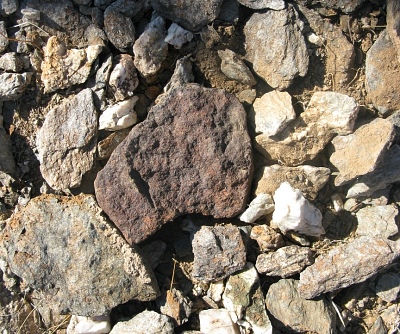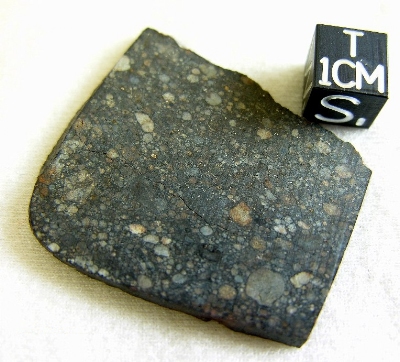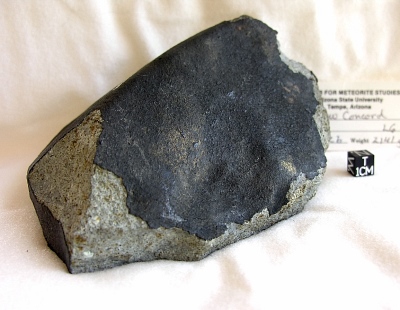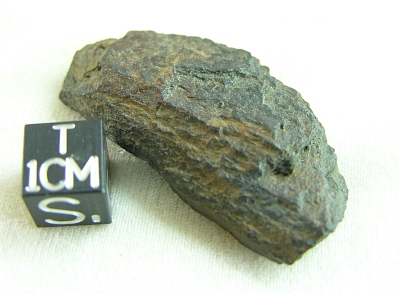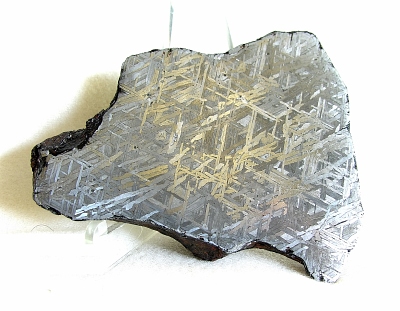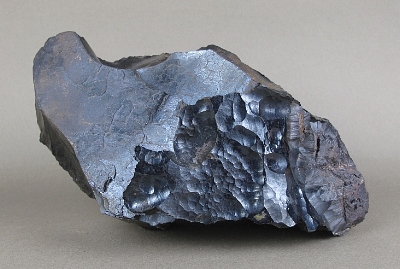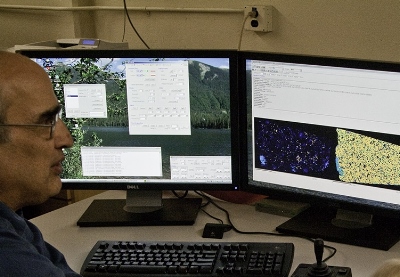IMCA Insights – May 2012
Introduction to Meteorites
by Dolores H. Hill
Meteorites are tangible
samples of the Solar System objects traditionally studied by ALPO
members and many other astronomy associations. They provide a connection
to such things as the meteors, minor planets, comets, lunar, Mars, and
even the Sun (as implanted solar gases).
Naming of Meteorites...
Unlike astronomical bodies, meteorites are not named after their
discoverers or even famous scientists. They are named after geographical
features, towns, or regions. Attempts are made to use names that are not
likely to change and are easily identifiable. It is only recently that
some standardization has been applied to the naming and official
recognition of meteorites. The Nomenclature Committee of the
Meteoritical Society is the official body for approval of names and
classifications of meteorites.
Where are Meteorites Found?
Gold Basin meteorite,
as found
(Photo courtesy of Aerolite.org)
Meteorites
generally fall at the same rate over the entire Earth. Because the
Earth’s surface is mostly water, most of them are lost. They are
recovered wherever people live and travel. This is evident on maps of
meteorite recoveries as "paths" during the building of large railroad
and road building projects. Meteorites are best preserved in dry
environments where weathering and rusting is relatively slow. They are
also more easily seen against light-colored soils and sparse vegetation.
In more temperate climates, meteorites begin to rust immediately after
falling and are subject to destruction from plant roots as well.
Thousands of meteorites have been found in Antarctica and the Sahara
Desert in the last 20 years. This is more than was known previously from
the entire world. Not only have these meteorites expanded the known
types but, they have increased our knowledge of ancient meteorite falls.
They have provided evidence of the timing of breakup and types of
asteroid parent bodies that produced the specimens in our laboratories.
Meteorite Types & Classification
Begaa: stony
meteorite, chondrite LL3 with numerous clear chondrules
(Photo courtesy of Anne Black)
Contrary
to popular misconception, not all meteoroids or asteroids are metallic.
In fact, most of the meteorites that fall on the earth are stony
meteorites called chondrites. They are named after tiny objects or
inclusions in them called chondrules. These are spherical, ~1 millimeter
diameter, silicate inclusions formed early in the formation of the Solar
System as the Solar Nebula coalesced; before any of the planets or
asteroids formed. Indeed, chondrites are the oldest rocks you can hold!
Other meteorite types represent a wide variety of conditions and
processes on various parent bodies. They provide valuable insight into
the Solar System's past throughout space and time. Iron-nickel and
stony-iron meteorites sample deep interiors of once large asteroids.
They are used as analogs for our own Earth’s core and mantle. Other
meteorites are brecciated; composed of broken fragments of asteroid
collisions whose record has been frozen in place.
The details of the meteorite classification scheme will not be discussed
here. As alluded to above, there are three main types: stony,
stony-iron, and iron-nickel. Each of these broad categories is broken
down into many types based on their mineral and chemical compositions.
The age-old battle between classifying "lumpers" and the "splitters" is
carried out as similarities and differences between individual
meteorites are learned. Scientific lumpers look for similarities between
samples and put them together in a category; splitters look for
differences between samples and create separate classifications or
categories. As more meteorites are recovered and we sample more Solar
System parent bodies, more sub-types seem to be required until a
unifying explanation can be found to link them to a common parent
asteroid. The three main types of meteorites are readily discernible by
eye but, sophisticated instruments are required to determine an exact
chemical classification. Sometimes, lengthy trace element analyses are
required to distinguish between some meteorite classes.
Where do Meteorites Come From?
We know that the meteorites in our scientific collections primarily
sample the asteroid belt between Mars and Jupiter. This is known from
orbits calculated of fireballs that were photographed and later
recovered. There is evidence that some meteorites were formed at
different distances from the sun. It is possible that some carbonaceous
chondrites are related to comets that sweep into the inner Solar System.
They are "primitive" chemically (unchanged since their formation early
in Solar System history) and some contain minerals that have been
exposed to water. We have been able to conclusively identify "lunar
meteorites" from their unique chemical signatures because we have real
samples of moon rocks from the U.S. Apollo and Soviet Luna missions.
Martian meteorites or "SNCs", named after the three type meteorites,
Shergotty, Nakhla, and Chassigny, were first known from compelling
circumstantial evidence. As more compositional data from the surface of
Mars becomes available, the connection is even stronger. We do not think
we have samples of Mercury or Venus but, meteoriticists have thought
about what kinds of compositions would be expected. There are a few
pre-solar grains trapped in carbonaceous chondrites that sample material
from a different solar system!
How is a
Meteorite Identified?
The most important comment to be made about meteorite identification is
that it ranges from very easy for those with "classic" fusion crust to
very difficult for older finds and/or unusual types. The specific
classification of a particular type of meteorite requires chemical
analyses by an institution with access to an electron microprobe and/or
a trace element laboratory. It is interesting to note that meteorites
contain the same elements and, with some important exceptions, similar
minerals as are found on the Earth.
Physical Appearance: Fresh Falls vs. Old Finds
New Concord, with
fresh black fusion crust,
fell on May 1, 1860, and recovered immediately
(Photo courtesy of Anne Black)
The first indication that a rock may be a meteorite is its outer surface. A fresh fall, i.e. a meteorite that is seen to fall and soon recovered, will exhibit a black surface. This outer coating or "fusion crust" is less than 1 mm thick. It ranges from a matte black luster to a glassy black depending on the stone's composition. The fusion crust is the last, quenched, outer layer of the meteorite as it passes through the atmosphere. It is an often misunderstood feature. Real fusion crust usually doesn't look particularly melted or vesicular. Fortunately for scientists, most of the interior is well preserved and not harmed by the heat of atmospheric passage. Would-be meteorite finders bring scientists many lumps of magnetite, volcanic rocks, slag, and even rocks containing calcite that are brought in because they "look melted".
Bendego: old, highly
weathered meteorite found in 1784 in Brazil
(Photo courtesy of Anne Black)
Meteorites
that are old "finds" will have lost the beautiful black color to the
fusion crust. Because meteorites are immediately attacked by Earth’s
atmosphere and moisture, they oxidize (rust), weather, and erode. They
often have an ugly, rusty, brown exterior that may be broken and
severely cracked. Some, although rusted, may retain traces of the
original fusion crust.
Density
While it is true that meteorites are denser than terrestrial rocks, it
is a poor criterion. Earth rocks containing mixtures of minerals, ores,
and basalts may, by chance, have a similar measured density. Iron
meteorites will be very heavy for their size, but iron-rich slag and
magnetite will be heavy also. Some stony meteorites may be
indistinguishable in the field from other rocks if density alone is
considered.
Magnetic Properties
Iron-nickel meteorites are strongly magnetic but stony meteorites will
be much less attracted to a magnet. Most stony meteorites contain small
grains of iron-nickel metal. They will be detected by a well tuned metal
detector even several inches below the surface. Unfortunately, many
ordinary rocks also exhibit magnetic properties. Rocks which are
strongly magnetic on one part but, not on another, are terrestrial
volcanic rocks, basalts, or other iron-rich rocks and industrial slag.
So, magnetism alone is not a very useful discriminator.
In summary, exterior appearance, density, and magnetism are useful aids,
but do not provide definitive tests by themselves. Unless a specimen is
obviously terrestrial or obviously a meteorite, a cut is required to
reveal the interior secrets. The first indication of a stony (chondrite)
meteorite is the presence of small, reflective metal grains or flecks in
a silicate groundmass. This groundmass can range from a light gray color
to dark black. Some but, not all, chondrites will exhibit ~1mm diameter,
circular, chondrules. Most people greatly overestimate how large these
are and often mistake sand grains in Earth rocks for chondrules. Other,
rarer, stony meteorites require careful microscopic or chemical analysis
by a meteorite laboratory.
Saint Augustine: Iron
meteorite found in 1974 in Illinois
(Photo courtesy of Anne Black)
Iron-nickel meteorites when cut will have a "nickel color". This can be
difficult to assess. A bluish hue to the metal or glassy, melted-looking
inclusions with vesicles indicate a manmade metal or slag. The famous
Nital etch can reveal the Widmanstätten pattern in a metal meteorite as
it preferentially etches the minerals at different rates. (Don’t try
this at home! It is a dangerous mixture). This crisscross pattern is
diagnostic of a meteorite because it is formed only by very slow cooling
in the interior of an asteroid. Often metal meteorites are positively
identified by analysis of their iron and nickel content with an electron
microprobe. A large amount of calcium, manganese, copper, zinc, silicon,
indicates a manmade origin.
Common Meteorwrongs
Hematite, a common
meteorwrong
(Photo courtesy of Aerolite.org)
The most
common meteorwrongs include magnetite, a black, heavy, magnetic rock,
industrial slags of all descriptions, old iron farm implements, iron
rich rocks, and volcanic rocks. Many brown or black rocks are sent to
labs in hopes that they are meteorites. Knowledge of the geologic or
geographic setting can be important in any explanation of the true
nature of a meteorwrong. For example, many rocks from deserts display a
thin, black coating called desert varnish that can look very much like
fusion crust but, is actually a terrestrial manganese oxide.
Testing Laboratories
Dr. K. Domanik
studying a sample of Almahata Sitta with the electron
microprobe, in the lab of the University of Arizona, Tucson, Arizona
(Photo courtesy of Full Moon Photography)
Meteorite
laboratories are usually associated with universities. They routinely
examine possible meteorites. Not all geology departments and not all
geologists have experience with meteorites. Reputable meteorite dealers
are also qualified to identify common meteorites. They, too, will seek
out scientific contacts for unusual rocks or meteorites. I have never
known of a dealer to be dishonest, that is, to tell a person that they
do not have a meteorite if they know it to be one. It may be
disappointing to be told that your find is an ordinary rock but, be
assured that there are plenty of real meteorites waiting to be found,
and more falling every day.
Because meteorite laboratories must examine possible meteorites in
between their regular work, there is no set time frame for completion.
An instant answer is usually a "no". Longer delays indicate that the
sample is "in the queue" and may not have been examined right away. Or
it may mean that it is a difficult to identify specimen that may or may
not be a meteorite after lengthy analyses. Certainly, any unusual or
rare meteorites are given highest priority.
The Scientific Record
The official recognition and naming of meteorites is carried out by the
Nomenclature Committee of the Meteoritical Society. It has set forth
rules that must be followed by institutions submitting information for
new meteorites. (See below). New meteorites are announced in the
Meteoritical Bulletin several times per year. A preliminary version is
posted on a website and the final, official version is published in the
journal, Meteorites and Planetary Science (MAPS). The Catalog of
Meteorites is a compilation of the Bulletins that has been published in
book form approximately every 10-20 years. Not only does it give one
great satisfaction to contribute to the scientific record but, there is
added satisfaction in seeing your name as the finder and/or owner of the
main mass of a newly discovered meteorite.
Other than for the sake of the scientific record for future generations,
why go through the trouble to have a meteorite properly classified and
recognized? One reason is that if you ever wish to sell it, you will
obtain a higher price for an officially recognized specimen with a real,
scientific classification. Without one, dealers understandably will pay
the "market price" for the least valuable type. If it turns out to be
one of the rare types of meteorites, they will be elated and you will
have missed an opportunity. Be forewarned, though, that while most
meteorites are ordinary chondrites, they also are not extremely valuable
either. Too often meteorite owners hope that theirs will allow them to
retire or buy a vacation home, etc. because of sensational T.V. programs
that emphasize the rarest types. The best way to enjoy a found meteorite
is to appreciate its scientific significance and proudly display the
specimen for all to see.
Collections
Display of meteorite
specimens, during the Tucson Show
(Photo courtesy of Anne Black)
Meteorite
collections are found all over the world. They are housed in large and
small museums, planetariums, universities, and private collections.
Museum collections are primarily for display and educational purposes.
They do occasionally provide specimens to researchers. Universities and
other institutions such as NASA-Johnson Space Center, maintain
collections for the purpose of scientific research. Individual
laboratory collections may be more specialized and, therefore, often
contain smaller or fewer samples than most collections. The Smithsonian
Institution is an example of an institution that serves a role as both
museum and research facility.
The most important part of any collection is to preserve the meteorites,
keep the original identifying labels with the specimen and to keep an
inventory list. Private collectors include amateur astronomers and
mineral collectors who just enjoy the idea of holding and preserving a
piece of an asteroid. Some attempt to collect an example of every "type"
of meteorite; some concentrate on falls; some collect them by alphabet A
to Z; some collect all meteorites found in one particular state or
country; some desire only the rarest samples to fill out their
collections. Many collectors are discovering the joys of thin sections;
30 micron thick, polished slices that reveal a new world under the
microscope.
Collectors include commercial meteorite dealers who have built beautiful
collections of both museum quality specimens and smaller pieces suitable
for the amateur and scientist. They, too have their favorites that are
considered part of their "private collection". Dealers often cultivate a
symbiotic relationship with scientific institutions and are, thankfully,
very generous to them. They provide an educational role to the public as
well.
What to Do if You Think You Have Found a Meteorite?
-
1. Send the entire rock to a meteorite laboratory associated with an educational institution for documentation of its original appearance, weight, interior structure, etc. It is wise to contact the institution ahead of time so the sample is expected and directed to the appropriate person.
-
2. Provide a complete description of the "find" location and circumstances. This information is needed to assign a permanent, official name to the meteorite, check for possible pairings of meteorites found in the same region, and allow for future recovery of more specimens. It is also important for proper recognition of the discoverer(s) and current owner(s) in the scientific record.
-
3. In accordance with the requirements of the Nomenclature Committee of the Meteoritical Society, 20% or 20 grams (whichever is smaller) of the specimen must be donated for curation for future research. The material needed for initial analyses by most laboratories would be taken from this 20% unless permission is obtained otherwise. Contrary to popular belief, laboratories never require donation of an entire specimen.
-
4. Most (all?) laboratories do not charge for their services. This is latter is fortunate for meteorite owners because the cost of materials, personnel, and instrumentation usually far exceeds the actual commercial value of the entire rock. It is in the interest of scientific research and public service that labs conduct such work. Most labs request the ability to conduct exclusive analyses on a particular meteorite until it has been classified. This is because, although there are several laboratories capable of conducting meteorite authentication and analyses, it is unproductive and, indeed wasteful, of time and resources for several labs to duplicate initial classification. They are contracted to carry out research as stated in funding proposals over a year in advance, so unfortunately that work takes priority over newly found meteorites. It may take a long time before classification is complete. Why wait? In addition to providing scientifically invaluable specimen for future curation, classification and official recognition is essential to collectors and dealers.
Do's
and Don'ts of Meteorite Preservation
The most important advice one can give about meteorite preservation is
that least is best! Never (!) attempt to remove fusion crust or soil
unless the latter rubs off very easily by hand. Fusion crust protects
the sample and its presence is highly prized by other collectors. It is
best to leave any cutting to professionals who have special saws, thin
diamond saw blades, inert diamond polishing compounds, and access to
high purity chemicals. It is difficult for the average well-meaning
person to know how a sample may become contaminated for scientific
studies or preservation.
In dry climates, only polyethylene bags or plastic boxes and desiccant
stored with the specimens may be needed. However, in moist climates,
sealed containers and cabinets with desiccant may be required to prevent
atmospheric attack of a collection. Certainly, moisture and oxygen
present the most serious threats to any meteorite. One must be careful
not to seal in moisture during storage. High temperatures to drive off
moisture should be avoided as they may also alter the chemical
properties of a meteorite for age dating. Several iron-nickel meteorites
display altered or lost Widmanstätten patterns due to reheating by their
finders.
Some collectors resort to coating their iron-nickel specimens with
special varnishes and lacquers, and even soaking in penetrating oils.
Oils may ooze out as time passes - or if placed into any analysis
instrument that uses a vacuum. (Dealers will sometimes use varnishes to
protect a specimen that will be on display in a humid climate. They will
always inform you). As a scientist with an eye to future studies and
techniques, these are met with mixed enthusiasm. Some may preserve a
specimen but, render it useless for any scientific studies. The
alternative is a rusty pile of debris. A person may not intend for a
specimen to be studied but, 20 or 50 years from now it may be the only
known piece of an important sample. For instance, for the ALH 84001
Martian meteorite and its claimed nanofossils; much of the scrutiny
depended on how it was collected, stored, and subsequently handled. It
was one of the "difficult" meteorites to classify and was later
discovered to be Martian because it was included in a study of other
rare meteorites.

Dolores Hill in the
Lab in the University of Arizona, Tucson Arizona
(Photo courtesy of Full Moon Photography)
Dolores
Hill, Senior Research Specialist, Lunar and Planetary Sciences,
University of Arizona, Tucson, Arizona, wrote this Introduction to
Meteorites for the website of the Association of Lunar and Planetary
Observers (ALPO) a few years ago. The latest meteorite falls and media
interest on the subject has attracted a lot of new comers to the field
of meteoritics and I believe it is important every now and then to
review the basics, so she has allowed the IMCA to reprint it here. Thank
you, Dolores.
Anne Black, Editor
This article has been edited by Anne Black and Norbert Classen.
•
IMCA Home Page •
IMCA Code of Ethics •
IMCA Member List
•
Join IMCA •
IMCA Meteorite Info
